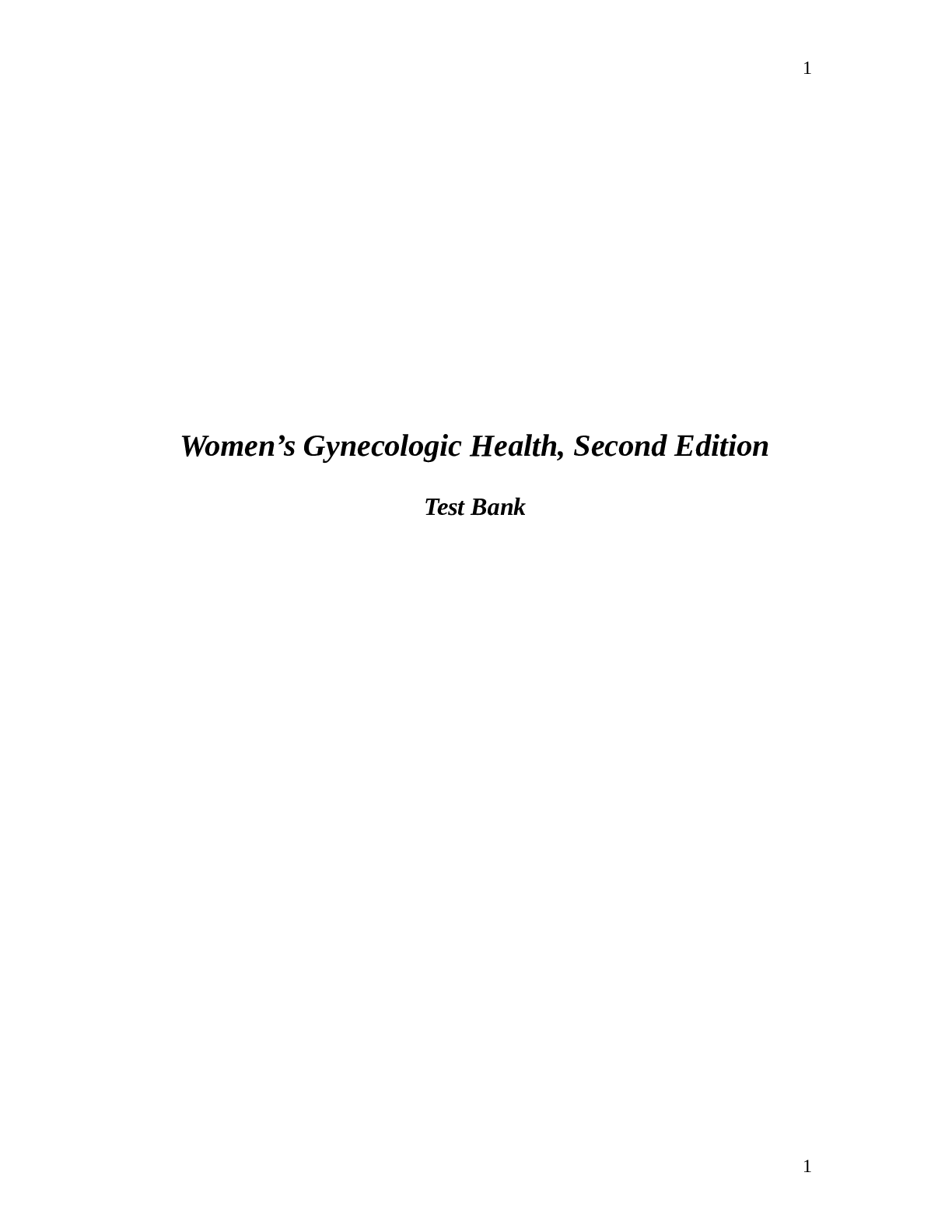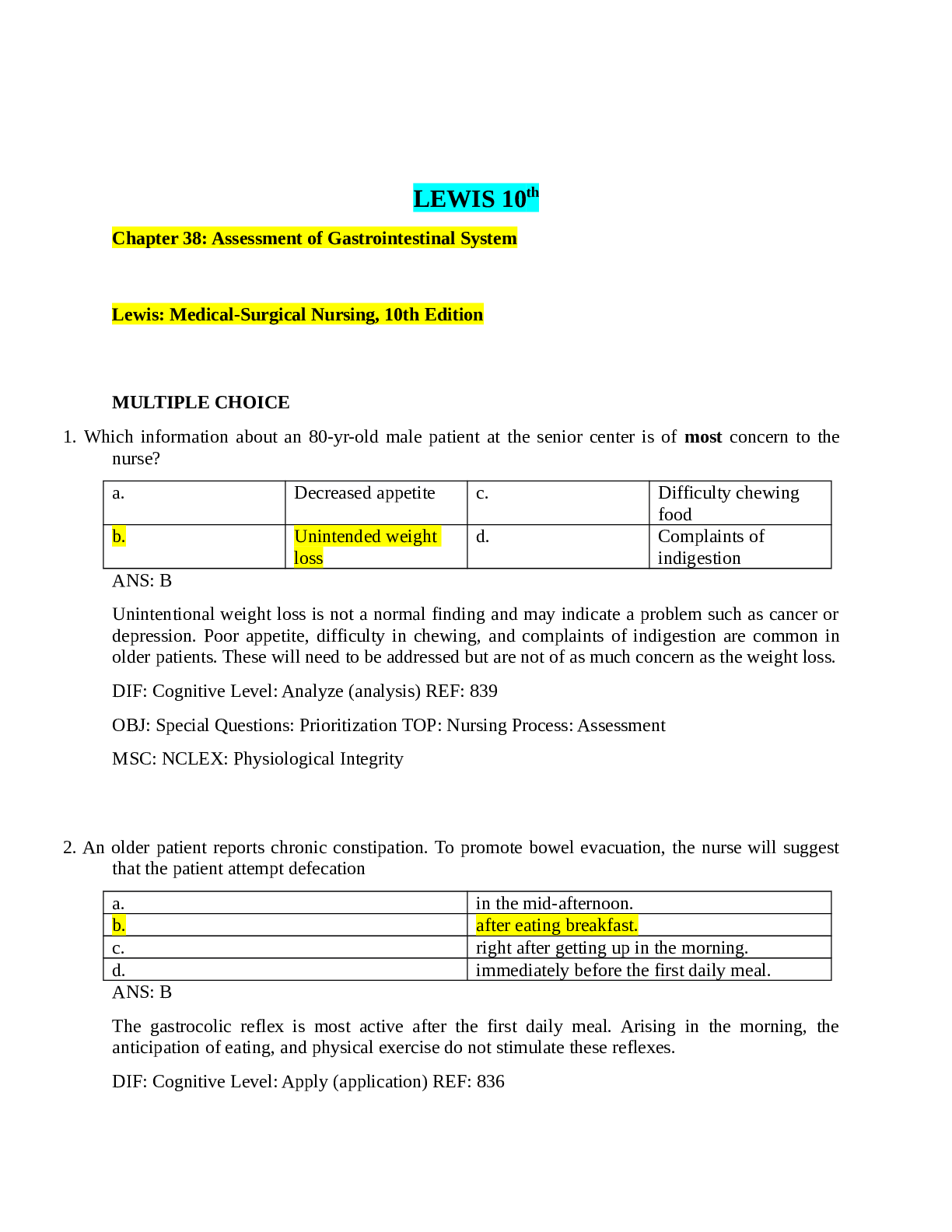*NURSING > TEST BANK > Chapter 19: The Pregnant Woman ; Bates’ Guide to Physical Examination and History Taking, 12th Edi (All)
Chapter 19: The Pregnant Woman ; Bates’ Guide to Physical Examination and History Taking, 12th Edition
Document Content and Description Below
Bates’ Guide to Physical Examination and History Taking, 12th Edition Chapter 19: The Pregnant Woman Multiple Choice 1. A 29-year-old homemaker who is G4P3 comes to your clinic fo... r her first prenatal check. Her last period was 2 months ago. She has had three previous pregnancies and deliveries with no complications. She has no medical problems and has had no surgeries. Her only current complaint is of severe reflux that occurs in the mornings and evenings. On examination she is in no acute distress. Her vitals are 110/70 with a pulse of 88. Her respirations are 16. Her head, eyes, ears, nose, throat, thyroid, cardiac, pulmonary, and abdominal examinations are unremarkable. On bimanual examination her cervix is soft and her uterus is 10 weeks in size. Pap smear, cultures, and blood work are pending. What is the most likely cause of her first-trimester reflux? A) Increasing prolactin levels B) Increasing ADH (antidiuretic hormone) levels C) Increasing progesterone D) Enlarged gravid uterus Ans: C Chapter: 19 Feedback: Progesterone lowers the esophageal sphincter tone, leading to reflux and heartburn. It also relaxes tone and contraction of the ureters and bladder, increasing risk of UTI and subsequent bacteremia. 2. A 26-year-old telephone operator comes to your office for her first prenatal visit. This is her first pregnancy. Her last period was about 2 months ago. She has no current complaints. She is eating healthily, taking vitamins, and exercising. She has a past medical history of an appendectomy as a teenager. Her mother had three children vaginally with no complications. On examination she appears healthy and her vital signs are unremarkable. Her head, eyes, ears, nose, throat, thyroid, cardiac, pulmonary, and abdominal examinations are also unremarkable. By speculum examination, her cervix appears bluish in color and highly vascular. A bimanual examination reveals a soft cervix and a 12-week-sized uterus. No masses are felt in either adnexal area. Results of her Pap, cultures, and blood work are pending. What clinical sign is responsible for her blue, highly vascular cervix? A) Chadwick's sign B) Hegar's sign C) Leopold's sign D) Leo's sign Ans: A Chapter: 19 Feedback: Chadwick's sign is observed during the speculum examination when the cervix appears more vascular and takes on a bluish hue. It can also occur with ectopic pregnancy. 3. A 22-year-old clerk, primigravida, comes to your office for a prenatal visit. She is in her second trimester and has had prenatal care since she was 8 weeks pregnant. Her only complaint is that she has a new brownish line straight down her abdomen. On examination her vital signs are unremarkable. Her urine has no protein, glucose, or leukocytes. With a Doptone the fetal heart rate is 140, and her uterus is palpated to the umbilicus. Today you are sending her for congenital abnormality screening and setting up an ultrasound. What physical finding is responsible for her new “brown line”? A) Corpus luteum B) Linea nigra C) Linea alba D) Diastasis recti Ans: B Chapter: 19 Feedback: The linea nigra is a linear hyperpigmented area of skin along the midline of the abdomen. It is caused by the hormonal changes of pregnancy. It is considered normal. 4. A 20-year-old college student comes in with symptoms of fatigue, nausea, and an increase in urination. Her last period was 3 months ago (June 20, 2008). She is sexually active and always uses condoms. Her past medical history is unremarkable. On examination you see a young, anxious-appearing woman. Her vital signs are unremarkable. Her head, eyes, ears, throat, neck, thyroid, cardiac, pulmonary, and abdominal examinations are unremarkable. On pelvic examination a soft cervix is palpated and a 14-week-sized uterus is palpated. A urine pregnancy test is positive. You then inform the patient that she is expecting and, using Naegele's rule, give her the estimated date of confinement (EDC, or due date). What was the due date you gave her? A) March 27, 2009 B) March 13, 2009 C) September 27, 2009 D) March 20, 2009 Ans: A Chapter: 19 Feedback: By Naegele's rule you add 7 days to the last menstrual period and then subtract 3 months. This gives you March 27, 2009. 5. A 19-year-old childcare worker comes to you for her first prenatal visit. She cannot remember when her last period was but thinks it was between 2 and 5 months ago. When she began gaining weight and feeling “something” moving down there, she did a home pregnancy test and it was positive. She states she felt the movement about a week ago. She has had no nausea, vomiting, fatigue, or fevers. Her past medical history is remarkable only for irregular periods. She has been dating the same young man for a year. She says they were not using condoms. On examination you see an overweight young lady appearing her stated age. Her head, eyes, ears, nose, throat, neck, thyroid, cardiac, and pulmonary examinations are unremarkable. Her abdomen is nontender, with normal bowel sounds, and the gravid uterus is palpated to the level of the umbilicus. Fetal tones are easily found with Doptone, and with the fetoscope a faint heart rate of 140 is heard. By speculum examination the cervix is bluish and by bimanual examination the cervix is soft. Results of Pap smear, cultures, and blood work are pending. You give the patient her due date and how far along she is, based on your clinical findings. An OB ultrasound to confirm her dates is ordered. With only the clinical examination, how many weeks pregnant did you tell this patient she is? A) 6 to 8 weeks B) 12 to 14 weeks C) 18 to 20 weeks D) 24 to 26 weeks Ans: C Feedback: Fetal tones can be easily found with Doptone and faintly auscultated with the fetoscope. The uterus is usually at the level of the umbilicus at 20 weeks. First-time mothers usually don't feel fetal movement until 19 to 20 weeks. 6. A 32-year-old attorney comes to your office for her second prenatal visit. She has had two previous pregnancies with uneventful prenatal care and vaginal deliveries. Her only problem was that with each pregnancy she gained 50 lbs (23 kg) and had difficulty losing the weight afterward. She has no complaints today. Looking at her chart, you see she is currently 10 weeks pregnant and that her prenatal weight was 130 lbs (59 kg). Her weight today is 134 lbs (60.9 kg). Her height is 5'4”, giving her a BMI of 22. Her blood pressure, pulse, and urine tests are unremarkable. The fetal heart tone is difficult to find but is located and is 150. While you give her first trimester education, you tell her how much weight you expect her to gain. How much weight should this patient gain during pregnancy? A) Less than 15 pounds (less than 7 kg) B) 15 to 25 pounds (7 to 11.5 kg) C) 25 to 35 pounds (11.5 to 16 kg) D) 30 to 40 pounds (12.5 to 18 kg) Ans: C Chapter: 19 Feedback: This is the appropriate amount of weight gain for a person with a normal BMI of 19.8 to 26.0. 7. A 35-year-old bus driver comes to your office for a prenatal visit. She is approximately 28 weeks pregnant and has had no complications. She is complaining only of heartburn and has had no fatigue, headaches, leg swelling, contractions, leakage of fluid, or bleeding. On examination her blood pressure is 142/92 and her urine shows no glucose, protein, or leukocytes. Her weight gain is appropriate, with no large recent increases. Fetal tones are 140 and her uterus measures 32 cm from the pubic bone. Looking back through her chart, you see her prenatal blood pressure was 120/70 and her blood pressures during the first 20 weeks were usually 120 to 130/70 to 80. What type of blood pressure is this? A) Normotensive for pregnancy B) Chronic hypertension C) Gestational hypertension D) Preeclampsia Ans: C Chapter: 19 Feedback: Gestational hypertension occurs in women who are normotensive before pregnancy and develop systolic pressures over 140 and diastolic pressures over 90 after week 20 of pregnancy. There will be no protein in the urine and no symptoms of preeclampsia such as rapid weight gain, leg edema, or headaches. These patients must be cautioned about symptoms of preeclampsia and receive aggressive follow-up. 8. A 26-year-old stewardess comes in for a third trimester prenatal visit. She has had prenatal care since her sixth week of pregnancy. She has no complaints today and her prenatal course has been unremarkable. Today her blood pressure and weight gain are appropriate and her urine is unremarkable. You have a first-year medical student shadowing you, so you ask the student to get Doptones and measure the patient's uterus in centimeters. The student promptly reports fetal heart tones of 140, but he is having difficulty obtaining the correct measurement. He knows one end of the tape goes over the uterine fundus. From what inferior anatomic position should the tape be placed? A) Vagina B) Clitoris C) Pubic symphysis D) Umbilicus Ans: C Chapter: 19 Feedback: In most women, measuring from the symphysis to the uterine fundus is approximately the same and very predictable for dating purposes. 9. A 24-year-old cashier comes to your clinic for her first OB visit. She had her last period 10 weeks before, which would mean she is 12 weeks pregnant. She did a home pregnancy urine test a month ago and it was positive. She has had some fatigue and nausea, but not in the last week. She has had no cramping or bleeding. Her vital signs, head, eyes, ears, nose, throat, thyroid, cardiac, pulmonary, and abdominal examinations are all unremarkable. On speculum examination her os is closed and there is a pinkish hue to the cervix. On bimanual examination the cervix is soft and the uterus is enlarged to the pelvic brim. Despite 20 minutes of trying, you cannot find heart tones. You repeat a urine pregnancy test and it is negative. A serum pregnancy test is ordered and is positive. You send the patient for a vaginal ultrasound. What is the most likely explanation for her presentation? A) Earlier than 12 weeks B) Fetal demise (missed abortion) C) False pregnancy Ans: B Chapter: 19 Feedback: This patient has lost some of the symptoms of pregnancy, including fatigue and nausea. Also, there are no fetal heart tones despite the 12-week uterus. A negative urine test indicated decreasing levels of beta HCG of pregnancy, although there is still enough to pick up on the more sensitive serum test. 10. A 26-year-old white female comes to your clinic at 38 weeks, complaining of intermittent contractions. They last for 30 seconds and are coming every 10 minutes. Her prenatal course has so far been uneventful. You send her to labor and delivery for a labor assessment. On vaginal examination she has effaced 4 cm, but you cannot feel a presenting part. You admit her for active labor; however, you wish to assess if she is vertex (baby's head is down), so you do the Leopold's maneuver. Palpating the upper pole with your hands, you feel a firm round mass. Placing your hand along the right side of her abdomen, you feel a smooth firmness. Palpating your other hand along the left side of her abdomen, you feel irregular bumps. Above the pelvic brim you feel a firm irregular mass. While awaiting ultrasound to confirm your diagnosis, you write the pertinent orders. How is this fetus presenting? A) Vertex B) Breech C) Transverse Ans: B Chapter: 19 Feedback: When a baby is breech you often cannot feel a presenting part with the cervical check. In a breech lie, the irregular firm mass (the buttock) will be at the pelvis, while the firm round mass (the head) will be at the uterine pole. 11. Jeannie is a 24-year-old pregnant woman who asks you today if her frequent urination is normal. Which of the following hormones is most likely responsible for this? A) TSH B) HCG C) Oxytocin D) Estradiol Ans: B Chapter: 19 Feedback: HCG resets the thirst receptors and releases ADH. Estradiol increases prolactin output in the anterior lobe of the pituitary to ready the breasts for lactation. Thyroid output increases in pregnancy, but the free T3 and T4 are kept relatively constant because of the increase in thyroid binding globulin. 12. Which of the following is the major effect of placental hormones? A) Insulin resistance B) Increased tidal volume C) Relative hypercortisolism, which may trigger labor Decreased lower esophageal sphin [Show More]
Last updated: 2 years ago
Preview 1 out of 13 pages

Buy this document to get the full access instantly
Instant Download Access after purchase
Buy NowInstant download
We Accept:

Reviews( 0 )
$11.00
Can't find what you want? Try our AI powered Search
Document information
Connected school, study & course
About the document
Uploaded On
May 06, 2022
Number of pages
13
Written in
Additional information
This document has been written for:
Uploaded
May 06, 2022
Downloads
0
Views
155




.png)






.png)









.png)


